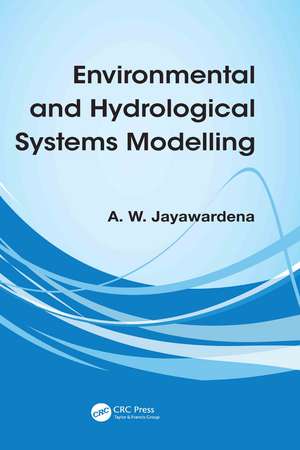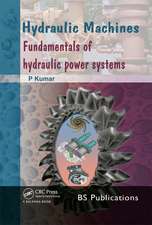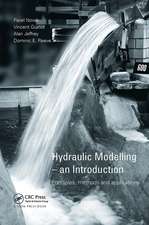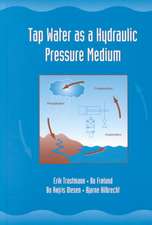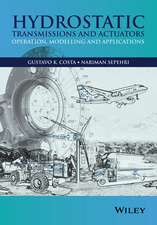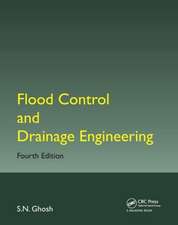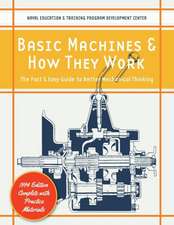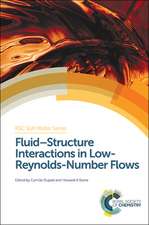Environmental and Hydrological Systems Modelling
Autor A. W. Jayawardenaen Limba Engleză Paperback – 21 ian 2014
Environmental and Hydrological Systems Modelling provides the tools needed by presenting different approaches to modelling the water environment over a range of spatial and temporal scales. Their applications are shown with a series of case studies, taken mainly from the Asia-Pacific Region. Coverage includes:
- Population dynamics
- Reaction kinetics
- Water quality systems
- Longitudinal dispersion
- Time series analysis and forecasting
- Artificial neural networks
- Fractals and chaos
- Dynamical systems
- Support vector machines
- Fuzzy logic systems
- Genetic algorithms and genetic programming
Preț: 587.65 lei
Preț vechi: 691.35 lei
-15% Nou
Puncte Express: 881
Preț estimativ în valută:
112.46€ • 116.98$ • 92.84£
112.46€ • 116.98$ • 92.84£
Carte tipărită la comandă
Livrare economică 14-28 aprilie
Preluare comenzi: 021 569.72.76
Specificații
ISBN-13: 9780415465328
ISBN-10: 041546532X
Pagini: 536
Ilustrații: 141 black & white illustrations, 41 black & white tables
Dimensiuni: 178 x 254 x 30 mm
Greutate: 0.99 kg
Ediția:New.
Editura: CRC Press
Colecția CRC Press
ISBN-10: 041546532X
Pagini: 536
Ilustrații: 141 black & white illustrations, 41 black & white tables
Dimensiuni: 178 x 254 x 30 mm
Greutate: 0.99 kg
Ediția:New.
Editura: CRC Press
Colecția CRC Press
Public țintă
Postgraduate and ProfessionalNotă biografică
A.W. Jayawardena obtained his undergraduate degree BSc (Eng) Hons from the University of Ceylon (now Sri Lanka) and postgraduate degrees MEng from the University of Tokyo, MS from the University of California at Berkeley, and PhD from the University of London. He is a Chartered Engineer, a Fellow of the UK Institution of Civil Engineers, a Fellow of the Hong Kong Institution of Engineers, and a Life Member of the American Society of Civil Engineers. His academic career includes many years of teaching in the Department of Civil Engineering of the University of Hong Kong; he was also a Research and Training Advisor to the International Centre for Water Hazard and Risk Management (ICHARM) under the auspices of UNESCO and hosted by the Public Works Research Institute of Japan, a Professor at the National Graduate Institute for Policy Studies, Japan, and an Honorary Professor in the Department of Statistics and Actuarial Sciences of the University of Hong Kong. He is currently an Adjunct Professor in the Department of Civil Engineering of the University of Hong Kong, Technical Advisor to the Research and Development Centre, Nippon Koei Co. Ltd. (Consulting Engineers), Japan, and a Guest Professor of Beijing Normal University, China. He has been a specialist consultant for UNESCO and for several engineering consulting companies in Hong Kong, including as an expert witness and provider of expert opinion in several legal cases in Hong Kong.
Cuprins
1. Introduction 2. Historical Development of the Systems Theory Approach to Modelling 3. Population Dynamics 4. Reaction Kinetics 5. Water Quality Systems 6. Longitudinal Dispersion 7. Stochastic Models – Time Series Analysis and Modeling 8. Artificial Neural Networks 9. Radial Basis Function Networks 10. Fuzzy Logic Systems and Their Variations 11. Dynamical Systems Approach - Phase Space Re-Construction 12. Genetic Algorithms and Genetic Programming 13. Wavelet Decomposition 14. Process Based (Distributed) Models 15. Model Parameter Optimization 16. Closure
Descriere
Providing the tools students and professionals need, this book details different approaches to modelling the water environment over a range of spatial and temporal scales. Their applications are shown with a series of case studies, taken mainly from the Asia-Pacific Region. Topics include linear systems, conceptual models, data driven models, process-based models, risk-management models, model parameter estimation as well as model calibration, validation, and testing.
